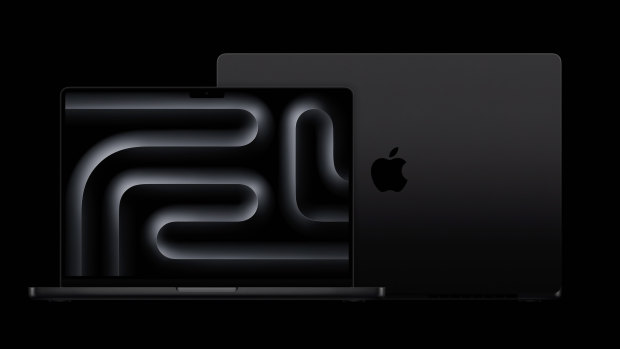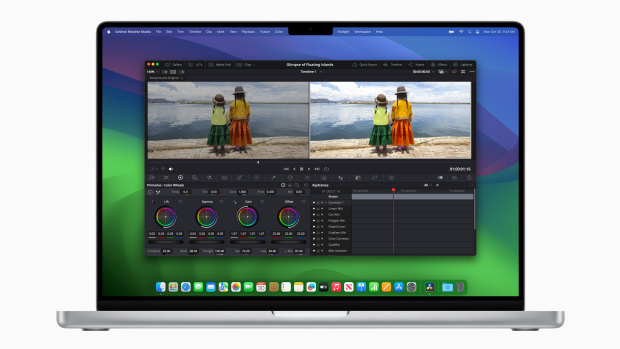
Save articles for later
Add articles to your saved list and come back to them any time.
Apple’s latest MacBook Pro models are unsurprising. Stacked to the gills with power thanks to the new M3 family of chips, they’re in every other way near-indistinguishable from the past few years of devices.
But that’s not necessarily a bad thing. For any professional with a laptop two or more years old, these could represent significant leaps forward in processing power, battery life, AI processing and more.
The new M3 MacBook Pro still comes in 16-inch and 14-inch models.
And while elements like the keyboard and cases haven’t changed much, the M3 is cutting edge. Built on a new three-nanometre processor, they feature much more efficient CPU cores and a lot of new graphical tricks. All M3s support hardware-accelerated ray-tracing and mesh shading, bringing them close to desktop-class GPUs for gaming and rendering. Plus Apple’s invented a new dynamic caching method that allows the GPU to adjust how much of the shared memory it needs to access in real time.
Physically, the new MacBook Pro is very familiar. It comes in a heavy, but portable 14-inch size or a backpack-stretching 16-inch, both featuring beautiful HDR displays with adaptive 120Hz refresh that I only wish weren’t marred by the unsightly notch up top, which houses the webcam.
They come in silver or a really nice sparkly new black, packing three Thunderbolt-4 ports, a full-size HDMI 2.1 and a full-size SD card reader. I, personally, find the screen and trackpad a little crampy on the smaller model when doing certain kinds of work, but it’s so much more portable. The 16-inch model is more than 35 centimetres wide, and weighs more than two kilograms.
In terms of configurations, the entry-level model is a 14-incher with the standard M3 chip, starting at $2700. This chip has an 8-core CPU, 10-core GPU and up to 24GB unified memory, and while it’s the least of the new chips, it’s absolutely no slouch. Apple says the CPU’s 35 per cent faster than 2021’s M1, and the GPU can deliver the same performance while using half the power.
Black seems like a pretty basic choice, but it looks great in person and isn’t as big a fingerprint magnet as the blue MacBook Air.
In my testing of this new entry-level chip, I found the new caching design paired with AI software like Apple’s MetalFX resulted in surprisingly good graphical performance. The new game, Lies of P, runs in HD and 60 frames per second no sweat.
The rest of the configurations, featuring the beefier M3 Pro or M3 Max, can go in either the 14-inch or 16-inch MacBook Pro – no matter which size you get, there are heaps of options for core count, unified memory and storage, with a theoretical maxed-out machine costing close to $12,000. Very few people will need to go anywhere near that though; an extremely powerful 16-inch model — M3 Max, 36GB memory, 1TB storage — is $5600. More storage is the most expensive optional extra.
My testing of a high-end M3 Max model featuring a 16-core CPU and 40-core GPU revealed a huge bump in performance. Massive 4K video exports took little more than a minute, which was more than half the time of my standard M3 machine and a little faster than my M2 Max Mac Studio, which has significantly more RAM. The M3 Max MacBook Pro also crushes other Macs in any GPU benchmarks, and I’m pushing games past 120 frames-per-second with ease.
For the kind of work tasks I usually do, this laptop was largely unaffected, and I could practically feel it rolling its eyes at the hours of browsing, image editing and word processing. It didn’t spin its fans, it didn’t blink and it sipped slowly on its battery for close to 20 hours.
On the highest-end M3, video post-production work on the highest-resolution content is astonishingly fast.
Playing high-end games, especially those not natively supported by Apple Silicon, was the only real way I found to make it work, and even then, it kept going for more than five hours. More appropriate tasks, of course, would be professional modelling or graphical development, AI training or video rendering.
There has been some controversy among Apple watchers when it comes to comparing the M3 chips to last year’s M2. Obviously, each of the three new chips is more powerful and more capable than their predecessors, but the middle child M3 Pro in particular is less of an improvement than some expected, at least when it comes to raw power and core count (in terms of efficiency, it’s still a huge gain).
It would seem that Apple is trying to adjust where the three chips sit relative to each other, moving the Pro closer to being a true middle ground between the entry-level chip and the Max, whereas it used to sit higher.
While this isn’t great for the purposes of getting to write big percentage point numbers in comparison to last year’s chips, it has literally no other negative impact. Only people looking to upgrade from a 2022 M2 Pro machine to a 2023 M3 Pro need take note.
Get news and reviews on technology, gadgets and gaming in our Technology newsletter every Friday. Sign up here.
Most Viewed in Technology
From our partners
Source: Read Full Article


